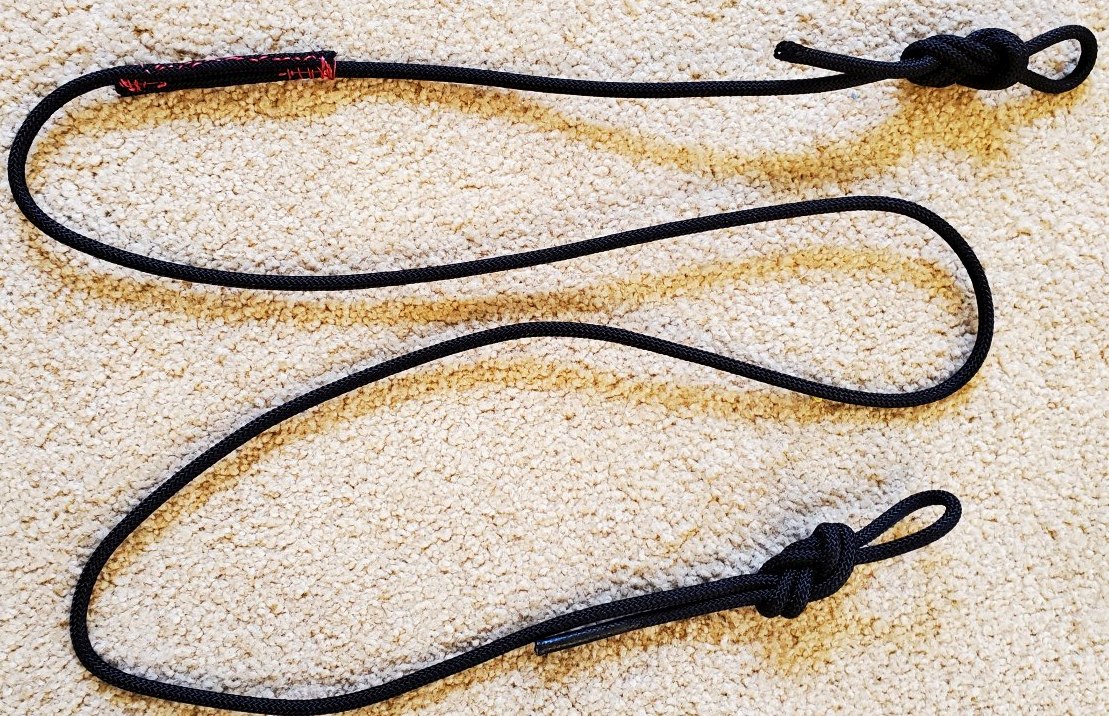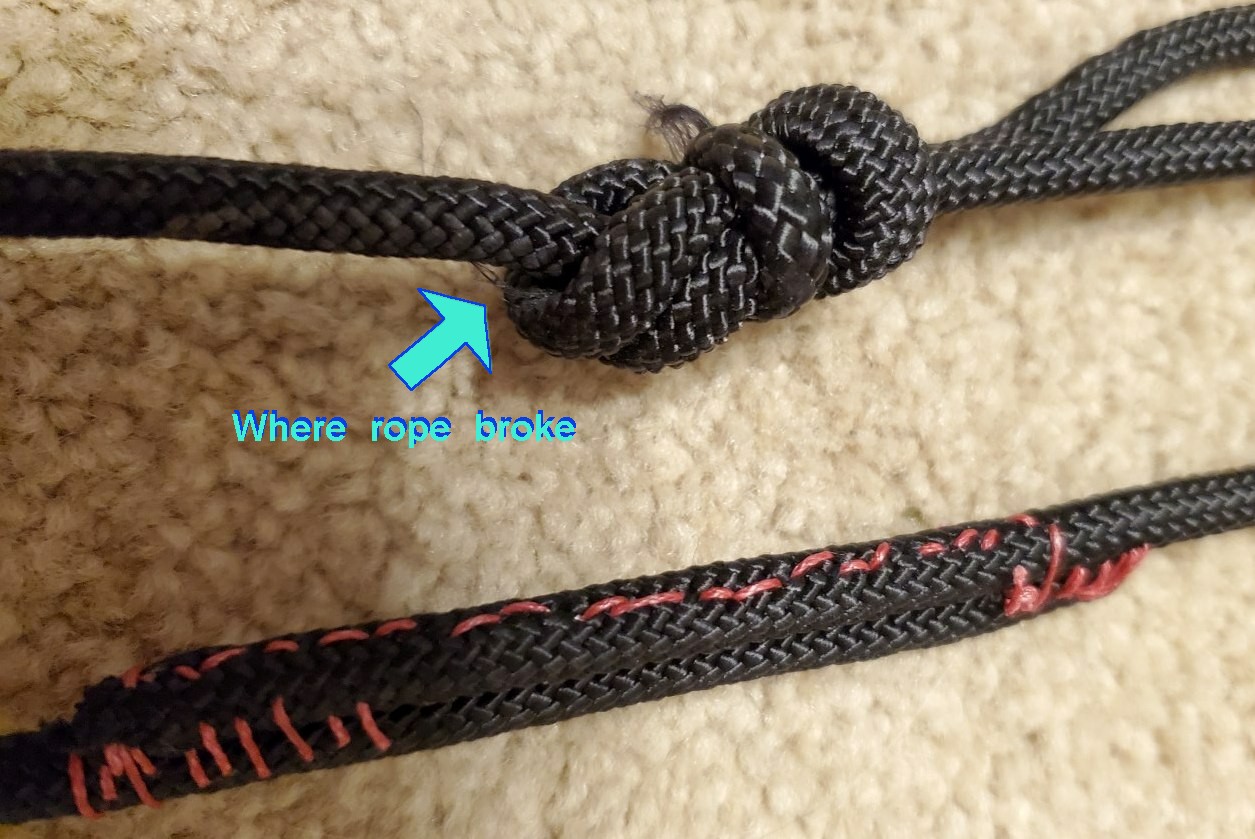
Titan Cord: Breaking and Sewing Rope (bottom line: sewing stronger than triple fisherman's)

*Attention!* don’t EVER sew rope, because major gear
manufacturers will tell you THAT YOU WILL SURELY DIE IF YOU DO. So read this
for curiosity only.
I sew rope all the time. I know the theory/rules
behind total stitching strength, I break test sewn samples, and I sew by hand with
100 lb test braided spectra or 300 lb test UHMWPE fishing line. But don’t YOU
try!
I picked up some black 5.5mm Bluewater “Titan” Dyneema/Nylon
tech cord out of curiosity. The most
curious thing I noted, was that no representative from distributors (such as
REI), or Bluewater, seemed to be able to determine where the nylon was in
Titan cord – distributed throughout, or mainly in the sheath. Perhaps
the problem is that Bluewater wants to arbitrarily change where it puts each
component in the future. This
lack of
information was surprising to me; I buy sailing ropes with polyester
sheaths
and Dyneema cores, and the exact details of construction are a major
selling
point of those ropes. (Note that some earlier studies refer to
“Spectra” in
Titan cord – I’m not sure if Bluewater once used Spectra in Titan, or
the experimenters were just confused because Titan SLINGS are made with
Spectra. In any
case Spectra and Dyneema are very similar, both made from UHMWPE.)
So I took my Titan cord, a pair of micro-serrated scissors
(Dyneema won’t cut with normal scissors), and clipped off an end. Immediately it seemed like the core was white
Dyneema with a few colored tracer strands of another polymer, and the sheath
was of nylon.
If you know anything about Dyneema, you know that until
recently, it came in one color: white. Black Dyneema was introduced by DSM Corp
about 2015; true black Dyneema is more costly than white Dyneema, and is not
used unless it will be visible (hence not in a core of two-polymer rope).
Dyneema in other colors is achieved primarily by two methods: 1) using
“companion fibers” of dyed nylon or polyester or another polymer, or 2) adding
a water-soluble urethane carrier that contains dye (the latter is used in
Amsteel braided Dyneema, via Samathane).
Another thing you may have noticed about Dyneema: it doesn’t
melt in a flame like nylon or polyester—it forms little mushroom-heads that are
very hard to shape. Below are three
stages in melting the ends of my tech cord. On left, I have cut the cord and
pulled back several mm of dark nylon, exposing the white Dyneema core; in
middle, I have clipped out the Dyneema core; and at right, I have melted the
nylon in a flame and pinched it back as one smooth end. If I had left the
Dyneema core in place, the nylon would have melted back and left a mess of
partially-decomposed Dyneema in the middle.
Conclusion: MY Titan is a black nylon sheath on a mainly
white Dyneema core.
Now how do you make slings or loops of the stuff? Bluewater
recommends triple fisherman’s knots, because as everyone knows, Dyneema is
slippery (but the knotting friction here is totally supplied by the nylon
sheath). Caution: this stuff is stiff and really hard to tie in 3x fisherman,
unless you start with really long tails, and you will end up losing a lot of
your cord to knots and tails, which will be very hard to pass through bights.
Here are Tom Moyer’s results for breaking a Titan cord made into a loop with a triple fisherman, along with comparisons to several other cordelette materials. The loop broke at ~3920 lbs, which means the knot broke at ~1960 lbs, since in his slow pull test, half the force should have been on each leg.

So I decided to sew the ends together. BUT REMEMBER THAT I AM NOT RECOMMENDING YOU
EVER SEW ROPE!
I overlapped 3” of cord, and used duct tape to hold 1/2" the cords together at each end. Then I sewed the cords together with
100 lb test braided spectra fishing line, as below. I do a penetration through
each strand for about 2” off length, needle in the plane of page, up and down,
snaking along (red lines); then I go back in the opposite direction (green).
Then I sew together the ends (blue) with penetrations through each cord, but
the needle perpendicular to the page.

My dominant hand is partly paralyzed, so it doesn’t come out
that neat-looking. I use a sailor’s palm thimble, and broad pliers to pull the
needle through the rope at times. The stitching shouldn’t be that tight, as you
don’t want the thread to preferentially cut through the fiber in the cord when
it is tensioned.
I tied a fig-8-on-bight on each end of the sewn Titan; one
end was directly tied around a linescale 3 set to 40 Hz and maximum force
record. The other end was tied to a fig-8-on-a-bight in 10.2 mm dynamic gym
rope, and the other end of the gym rope was attached to the tow hook of my jeep
(the gym rope provides a slight buffer, allowing me to apply the force over
about 2 seconds). And then I let my Jeep roll downhill till the lines were
taut, and hit the gas for ~2 seconds till the line snapped. Post-test picture
below.

The Titan broke in the knot at 1966 lbs, ~65% of
the advertized pure rope breaking strength (typical for figure 8 knots).
The sewn section
was unbroken and showed no signs of strain. The sewn section was
stronger than
the knot, and stronger than indicated in Moyer’s test of a triple
fisherman’s
in Titan.
I don’t know the real strength of the sewing; just
that it
is at least as strong as a figure 8 knot, and by comparison with
Moyer's test, at least as strong as a triple fisherman’s. I could have
used two methods to
get closer to breaking the stitched section: 1) modified trilene knot
on each
end, which would take a great deal of cordage and typically breaks at
> 90%
of the true rope; 2) capstan clamp, winding 4’ of cord around fixed
cylinders at
each end. Neither was practical, as I wanted to use 14’ of the original
20’ of
cord.
And for the last time, DON’T YOU EVER TRY SEWING ROPE!